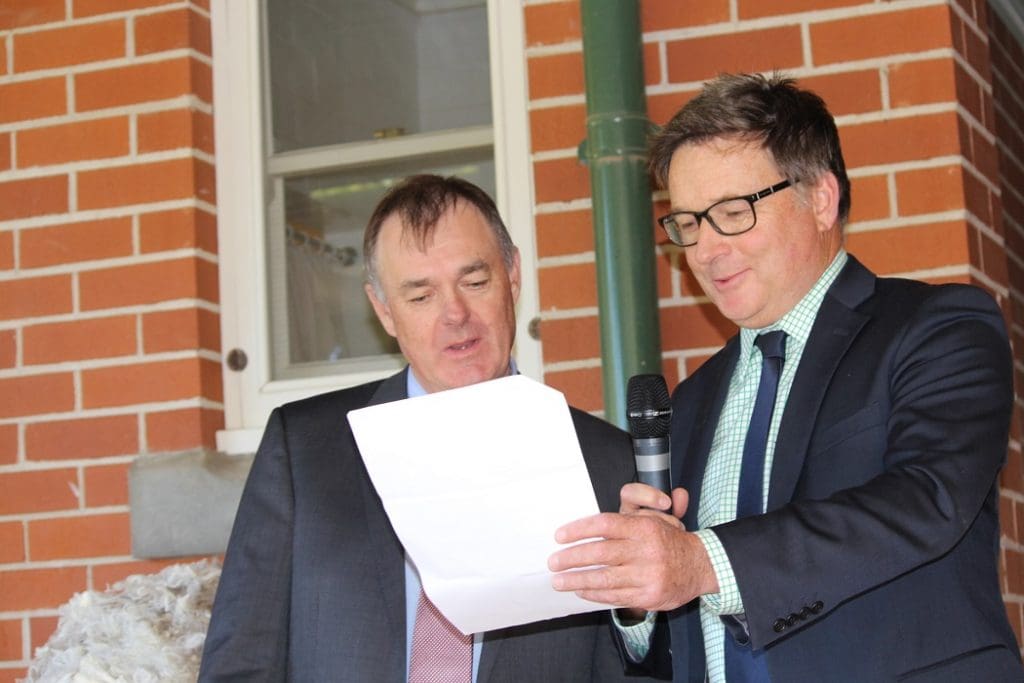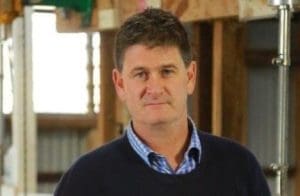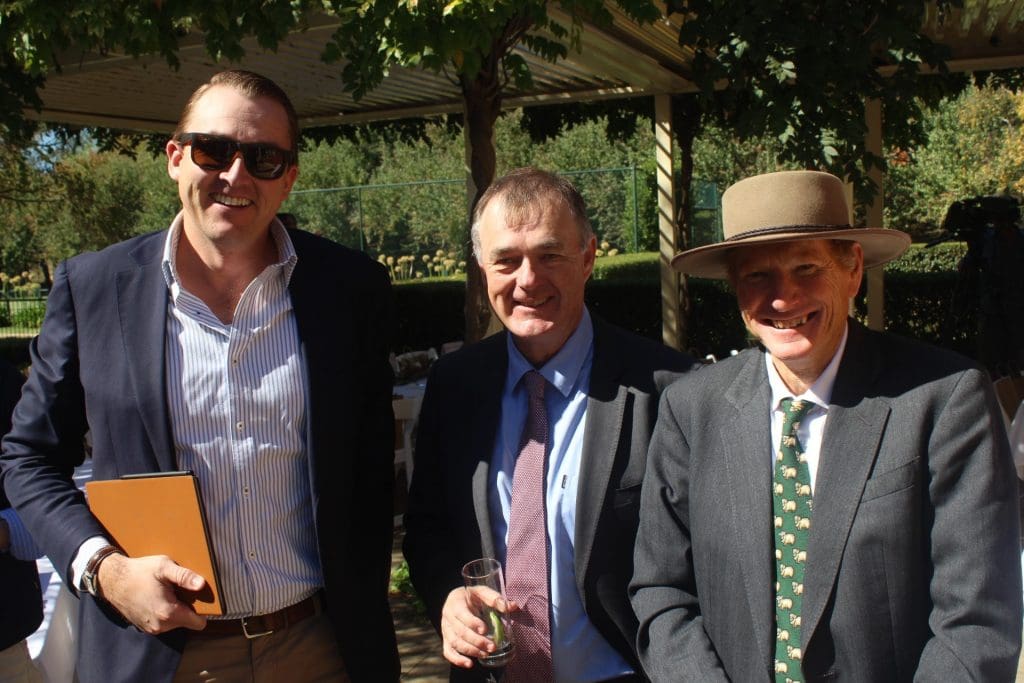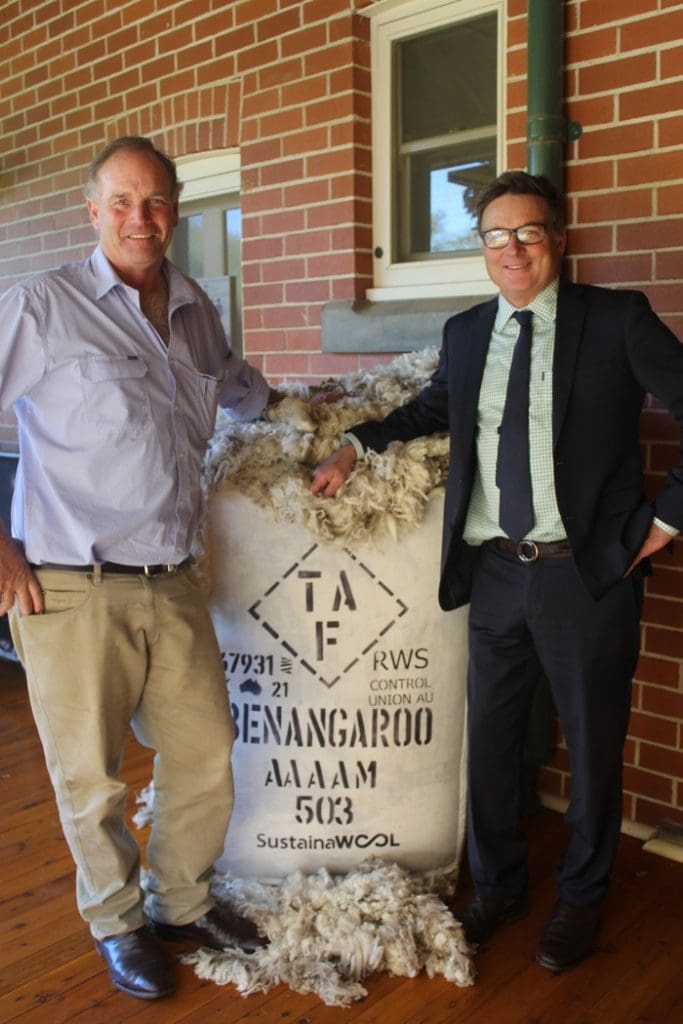
Sheep producers Australia chair Chris Mirams, left, and WoolProducers Australia president Ed Storey launched the sheep sustainability framework yesterday.
AUSTRALIA is well-placed as a sustainable producer of wool and sheep meat, but it needs to continue to prove it to the world, according to marketers and producers at the nation’s sustainability framework launch this week.
Peak industry bodies, Sheep Producers Australia and WoolProducers Australia, yesterday launched the world’s first sheep sustainability framework at Jugiong in New South Wale’s Riverina region.
The framework has 21 priorities across four themes – caring for our sheep; enhancing the environment and climate; looking after our people, our customers and the community, and; ensuring a financially resilient industry.
The framework’s priorities have 60 different indicators and metrics with data sources to be reported on for progress to be recorded by the industry.
Customers want sustainability verified – Blanch

New England Wool managing director Andrew Blanch.
At the end of a video explaining the framework, sheep sustainability group member New England Wool managing director Andrew Blanch posed a key question.
“I like to be aspirational, so wouldn’t it be wonderful to think that Australia becomes the ‘go to’ country for sustainable sheep meat and wool?”
Mr Blanch is a member of the sheep sustainability steering group and said Australia had to be able to prove that it deserves to be the ‘go to’ country for sustainable wool production.
“Because no-one else does”.
“I believe that we probably are the best one, but it is really difficult for us to prove that in front of the rest of the world, unless we have a solid way of actually measuring and reporting it,” he said.
“Sustainability now has become a big word, and you can’t just make the claim that ‘we are sustainable’ – no-one accepts that anymore.
“They want it verified.”
Mr Blanch said he liked that the framework did not make out that any of its four pillars were more important than the others.
“They’ve come together like a cogs and they work like a machine, all together – I think that’s really important.”
Wool quality is a key priority
But Mr Blanch said that one area that needed to also be a priority and not forgotten was the quality of the product.
“Because in the end you can have as many bits of paper that tick off that you’ve done this, this and this, but if the customer and consumer don’t find quality in the final product they’re getting, we have achieved very little …. and that’s where we’ve got a bit of work to go, and that’s all around the world”.
“It seems that we are all very excited about having the piece of paper and saying ‘this is what we’ve done’, but please don’t forget the product that we sell, whether it be meat, wool, or whatever,” he said.
“The quality of the product itself should not be secondary in my opinion.”
Mr Blanch said the most important thing is that Australia’s customers have all the information in their hands about the production of the nation’s meat and wool – total transparency and traceability.
Mr Blanch said it was unfortunate that the issue of mulesing was a focus in wool sustainability discussions.
“I don’t think we do animal welfare bad at all, quite the contrary, but removing mulesing is something that we have to be able to manage in some way, shape or form.
“I know it is not easy, and it’s our biggest challenge.”
SustainaWOOL program manager Dr Paul Swan said Australia has been the ‘go to’ country for sustainable wool production for decades.
“However, what is happening now is that there is a new suite of measurements that industries need to have to prove their social license, and this is about sustainability and ethics.
“We as a country have got a way to go to be leaders in that space, but we are investing in that space,” he said.
“The SustainaWOOL program I manage and the National Wool Declaration are examples of that.
“There is no questioning the technical quality of Australian wool,” he said.
“Our challenge is to demonstrate mastery of these new technical qualities that are about traceability and sustainability, and declare it.”

Gundagai Meat Processors CEO Will Barton, left, with Sheep Producers Australia chair Chris Mirams, and Dr Bruce Allworth at the framework launch.
Steering group member and Gundagai Meat Processors chief executive officer Will Barton said he was not sure how the world consciously ranked countries on sustainability.
“But I think we are very well placed.
There are not a lot of countries that can produce livestock as efficiently, naturally and sustainably as us,” he said.
“I think if anybody objectively walked through all of the elements involved, yes we would be the ‘go to’ country for sustainable meat production.
“But I would add to that that it’s not good enough just to be the best, you have to be measuring all of the reasons you are the best and using that as a tool to market yourself to the right people,” Mr Barton said.
“So what this framework does, it allows you to test all of these things, measure them and then report on the trends so that you actually prove them.
“In our business, we would say that you can’t manage anything that you can’t measure,” he said.
“So I think what this will do is indicate that we are (the ‘go to’ country) and then it is up to us to stretch and improve.”
Steering group member and Hamilton sheep and wool producer Mark Wootton said Australia is already the ‘go to’ country for sustainable sheep meat and wool production because of its scale, but he agreed with the need for ongoing transparency.
“I think consumers want products that are verifiable and traceable, the robustness of that is going to be important.”
Next steps are customer and producer engagement

Benangaroo Station owner Michael Field, left, with WoolProducers Australia president Ed Storey at the framework launch.
Sheep Sustainability Group chairman Dr Bruce Allworth said the framework currently has reported on just over half of the 60 metrics.
“But the work is going in to actually report on what we see is important and get the data and robust data set (for all the metrics),
“So that is going to be the real work over the next 12 months, is to make sure that everything we are aiming to report we can actually report,” Dr Allworth said.
A consultative committee of stakeholders – within the industry and further down the pipeline — has been set up, and will be guiding any revision of the identified metrics, he said.
“The other thing that is going to be really important is that the industry stakeholders take hold of the framework and engage our customers and get them involved.”
Dr Allworth said the launch was to a select group of mainly industry people and initially organized under COVID rules that restricted the number of people able to attend to 40 people at a private home – in this case the Field family’s Benangaroo Station near Jugiong.
“Now having launched that framework within our industry we now need to engage our customers.
“In the end, it is not about the launch it is about the engagement with the framework,” he said.
“The launch was a showpiece with media activity, but really the hard work is from now onwards to get a lot of buy-in.”
Dr Allworth said the framework already had a lot of buy-in from meat and wool processors, and at a meeting with state farming organisations and peak industry councils in February the bodies talked about taking it to their producers.
Dr Allworth said the framework’s preparation was jointly funded by Meat & Livestock Australia and Australian Wool Innovation, but this did not include establishment of another industry bureaucracy.
“Absolutely not, and it’s not about requiring anyone to do anything other than somebody going to the effort of gathering information that is already out there.
“And if it is not out there and it is important that the industry needs to know these figures, if we don’t have them then industry organisations such as MLA and AWI are highly likely to fund getting it, if we have identified that it is important to the industry that it knows what is happening.”

What is sustainability? Is it another bullshit word like ‘best practice’?
Sustainability focuses on meeting the needs of the present without compromising the ability of future generations to meet their needs. The concept of sustainability is composed of three pillars: economic, environmental, and social, and also know informally as profits, planet and people.
Profits come from making the consumer feel good. Farmers are very conscious of their land.
People: Is the industry meeting the needs of people? Who are the most important people? In the case of meat, the consumer is the most important person, who in turn is influenced by price and eating quality — taste and tenderness — and without chemicals. Most people would like to see the animals ethically produced. Ethical: those who have others’ interests in mind, including animals.
In the case of wool, what is the greatest stumbling block at the moment? Is wool being produced ethically? Do we need to consider breeding the hard wrinkle off sheep, so mulesing can be phased out?
Mr Andrew Blanch, you have hit on a very important subject, wool quality. Quality wool will sell its self. You don’t have to advertise. Next to skin wear, women’s apparel that doesn’t itch, pill or shrink. Wool for Suits that are fit for purpose.
ASBV’s are not helping, people are able to identify a good set of numbers more easily than quality processing wool. It is hard to make a silk purse out of a sow’s ear.